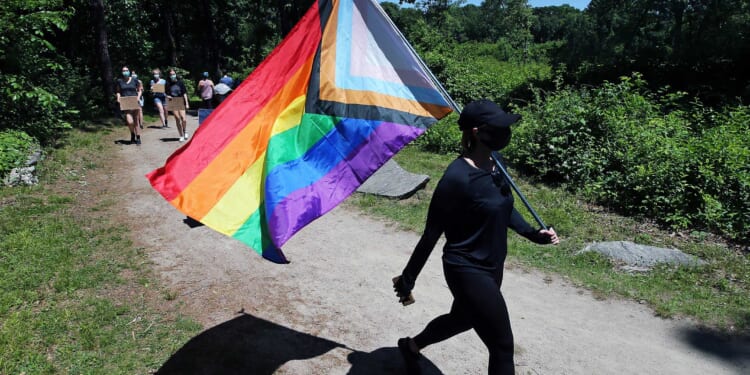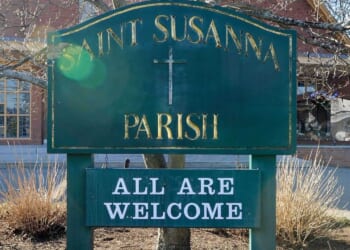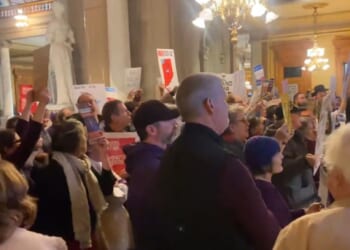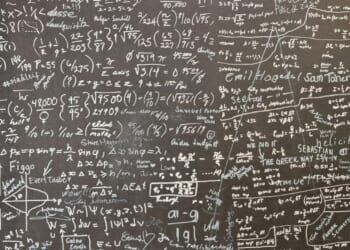
Be Gay, Do Crime: Everyday Acts of Queer Resistance and Rebellion, edited by Zane McNeill, Riley Clare Valentine, and Blu Buchanan (PM Press, 304 pp., $24.95)
You may have seen the phrase “Be Gay, Do Crime” before. It appears in bright neon as graffiti after a protest, next to an image of a dumpster fire or opossum, as a sticker on a radical professor’s brand-new MacBook, or in the social media bio of a particularly vitriolic Internet troll. The meme has also made its way to bookshelves in the form of Be Gay, Do Crime: Everyday Acts of Queer Resistance and Rebellion, a recently released anthology from the radical publishing house PM Press.
Finally, a reason to check your email.
Sign up for our free newsletter today.
The book is openly revolutionary. It acts as a source for those “wanting to learn from the past to gain inspiration and tactics for the struggles going on in the present,” pushes against “normativity,” argues for radical and militant “queer politics,” and expresses a degree of historical revisionism that would make the most ardent propagandist blush.
This approach fits squarely into the agenda of the book’s publisher, PM Press, founded by Ramsey Kanaan, a self-identified anarchist Communist who earlier founded another radical publishing house, AK Press. Kanaan believes in “institution building,” which he sees as a form of long-term organizing that helps revolutions take advantage of critical historical moments. Kanaan argues that the George Floyd riots were one such moment: “the biggest mass movement—certainly in American history. . . . I mean mass movement in the sense that there were more people on the streets, consistently, over a longer period of time than ever before in American history.”
During the fissiparous year of 2020, PM Press published Working Class History: Everyday Acts of Queer Resistance and Rebellion, with a foreword by Noam Chomsky. The book was so popular and widely acclaimed in radical left-wing circles—it claims to be “the most popular online people’s history project in English, reaching an audience of tens of millions”—that it inspired PM Press’s Everyday Acts book series, the first entry of which is Be Gay, Do Crime.
One striking aspect of this book is how often it revises history to fit its radical “queer” agenda. It frequently assumes that various historical figures were gay, bisexual, or even asexual based on the scantest evidence. That includes Gone With the Wind Oscar-winner Hattie McDaniel and Alexander Berkman, the attempted assassin of American industrialist Henry Clay Frick whose allegedly homoerotic prison writings are enough to make him a bisexual icon.
In any other historical book, such thin evidence might be relegated to a footnote, if mentioned at all. But Be Gay, Do Crime uses it to establish these individuals as pivotal figures in gay history.
The book even baptizes entire historical events as queer resistance after the fact, such as the 1999 World Trade Organization protests in Seattle. But topping all examples might be the labeling of Red Cloud and Crazy Horse’s victory against Captain William J. Fetterman and his men in the 1866 Battle of a Hundred Slain as an event “prophesied by a winkte, a revered Two-Spirit individual.”
No less important than what the book invents is what it omits. One of the more appalling examples concerns the 2017 police-involved shooting of Scout Schultz on the campus of the Georgia Institute of Technology. Be Gay, Do Crime leaves out key facts: Schultz left three suicide notes; he had falsely reported to police that someone was outside a dorm armed with a knife and a gun; officers arriving at the scene found Schultz outside holding what they thought was a gun but later turned out to be a multitool; Schultz approached the cops, shouting, “Shoot me!” By omitting this information, the book leaves the reader with the impression that Schultz was the victim of an unjustified police killing rather than a virtually textbook example of “suicide by cop.”
The only redeeming aspect of the book’s strange histories are its several highly entertaining accounts of left-wing struggle sessions. These include the collapse of Sacramento Pride in 2019, which led to a counter-protest over the inclusion of uniformed gay police officers; a Black Lives Matter protest of Toronto Pride for being too white; and the disruption of a Pride reception at the Obama White House by a trans activist who accused the president of torturing trans women in immigrant detention centers.
The book’s attempt to associate “queerness” with anticapitalism and antinormativity is part of a broader turn on the left. Whether it involves calls to abolish the family, praise for terrorist groups, or contempt for figures like Pete Buttigieg for not having neon hair and facial piercings, these instincts reflect a sweeping desire to invert every societal norm.
The book also valorizes “direct actions”—forms of protest, often militant, where activists intervene directly instead of relying on the political process or societal change. Anarchist activist Cindy Barukh Milstein highlights this focus in her foreword when she praises the book as a weapon that will teach activists “a diversity of badass tactics in order to smash fascism, dismantle empires, and cancel cops.”
Some of the highlighted stories are absurd, like when QUEEROCRACY and AIDS Coalition to Unleash Power got naked in then-House Speaker John Boehner’s office to protest budget cuts. Others are examples of domestic terrorism, like when Stop Cop City protesters took over an outpost and torched a police vehicle to honor the memory of a queer comrade killed in a shootout with police. The book frames many protests against oil pipelines, such as those against Dakota Access and the Mountain Valley Pipeline in Virginia, as militant queer actions.
Mutual aid networks—leftists’ preferred term for the problematic word “charity”—get plenty of attention, but always in the rosiest terms. For example, the book’s account of the Street Transvestite Action Revolutionaries (STAR) and their house for wayward youth fails to grapple with the fact that it was funded in part by its members’ “sex work” and housed in a glorified drug den with no working utilities and a revolutionary veneer.
So, should you read Be Gay, Do Crime? Yes, absolutely. Some readers will find it a horrifying portrayal of the mutilation of history that would result if the far Left were ever to gain power. Others will come away realizing that radical contingents truly exist that seek to dismantle society.
Above all, principled conservatives should read this book to understand the radical politics of their opponents—and to be aware of the publishing houses that promote these ideas. Indeed, in many cases, these are the same presses that publish the works of radical professors on college campuses. Whenever a professor makes headlines for expressing extremist views, I search his name on PM Press or AK Press for a match.
Far-left activists often operate like Bond villains, telling you their entire plan before they try to carry it out. Be smart and listen—whether by reading books like Be Gay, Do Crime or by watching, say, a livestreamed book launch featuring a radical professor. The radical Left is working hard to win hearts and minds for its revolution. The least we can do is pay attention.
Photo by Jim Davis/The Boston Globe via Getty Images
Source link


















